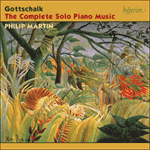What young pianist-composer living in Paris in the late 1840s could help but fall under the influence of Frédéric Chopin? The Polish composer was at the height of his considerable celebrity; one of the many forms he had popularised and/or invented for the piano was the mazurka; Chopin’s mazurkas made his publishers happy. It would seem from these two Gottschalk apprentice works that any mazurkas would make a publisher happy. Though written when he was seventeen, by the time they appeared in print five years later, ‘L. M. Gottschalk de la Louisiane’ (as he was credited on all his early publications) was a celebrity himself, famous enough for anything bearing his name to sell. Op 6 No 1 in A is pastiche Chopin; the chromatic theme of Op 6 No 2 frames a second episode in E major, repeated in F major. In truth, the most distinctive thing about
Colliers d’or is the title—‘Gold Necklaces’—publisher’s window-dressing if ever there was.
from notes by Jeremy Nicholas © 2003
Quel jeune pianiste-compositeur vivant à Paris à la fin des années 1840 pouvait éviter de tomber sous l’influence de Frédéric Chopin? Le compositeur polonais était alors au sommet de sa considérable célébrité, et l’une des nombreuses formes qu’il popularisa et/ou inventa pour le piano fut la mazurka; les mazurkas de Chopin faisaient le bonheur de ses éditeurs; et il semblerait, à en juger par ces deux œuvres de jeunesse de Gottschalk, que n’importe quelle mazurka fût propre à faire le bonheur d’un éditeur. Bien qu’écrites à l’âge de 17 ans, elles ne parurent que cinq ans plus tard, et «L. M. Gottschalk de la Louisiane» (comme le désignent toutes ses premières publications) était entre-temps devenu suffisamment célèbre pour que tout ce qui portait son nom fût assuré de se vendre. L’opus 6 no 1 en la est un pastiche de Chopin; le thème chromatique de l’opus 6 no 2 encadre un second épisode en mi majeur, répété en fa majeur. À vrai dire, l’élément le plus remarquable de ces
Colliers d’or est leur titre, habillage commercial de l’éditeur s’il en est.
extrait des notes rédigées par Jeremy Nicholas © 2003
Français: Josée Bégaud
Welcher junge Pianist-Komponist, der im Paris der späten 40er Jahre des 19. Jahrhunderts lebte, hätte sich dem Einfluss von Frédéric Chopin entziehen können? Der polnische Komponist befand sich auf dem Höhepunkt seiner beachtenswerten Karriere. Eine der vielen Formen, die er popularisiert und/oder erfunden hatte war die Mazurka. Chopins Mazurken waren bei seinen Verlegern beliebt, und von diesen beiden Mazurken Gottschalks her zu urteilen, scheint es, dass alle Mazurken bei den Verlegern beliebt waren. Zwar hatte er sie im Alter von siebzehn Jahren geschrieben, als sie jedoch fünf Jahre später im Druck erschienen, war „L. M. Gottschalk de la Louisiane“ (wie er in allen frühen Publikationen aufgeführt ist) selbst bereits so prominent, dass sich mit seinem Namen alles verkaufen ließ. Op. 6, Nr. 1 in A-Dur ist ein Chopin-Pastiche; das chromatische Thema von Op. 6, Nr. 2 umrahmt eine zweite Episode in E-Dur, die dann in F-Dur wiederholt wird. Tatsächlich ist die charakteristischste Eigenschaft von
Colliers d’or der Titel—„Goldene Halsketten“—„Auslagendekoration“ des Verlegers par excellence.
aus dem Begleittext von Jeremy Nicholas © 2003
Deutsch: Viola Scheffel


 Gottschalk: The Complete Solo Piano Music
Gottschalk: The Complete Solo Piano Music
